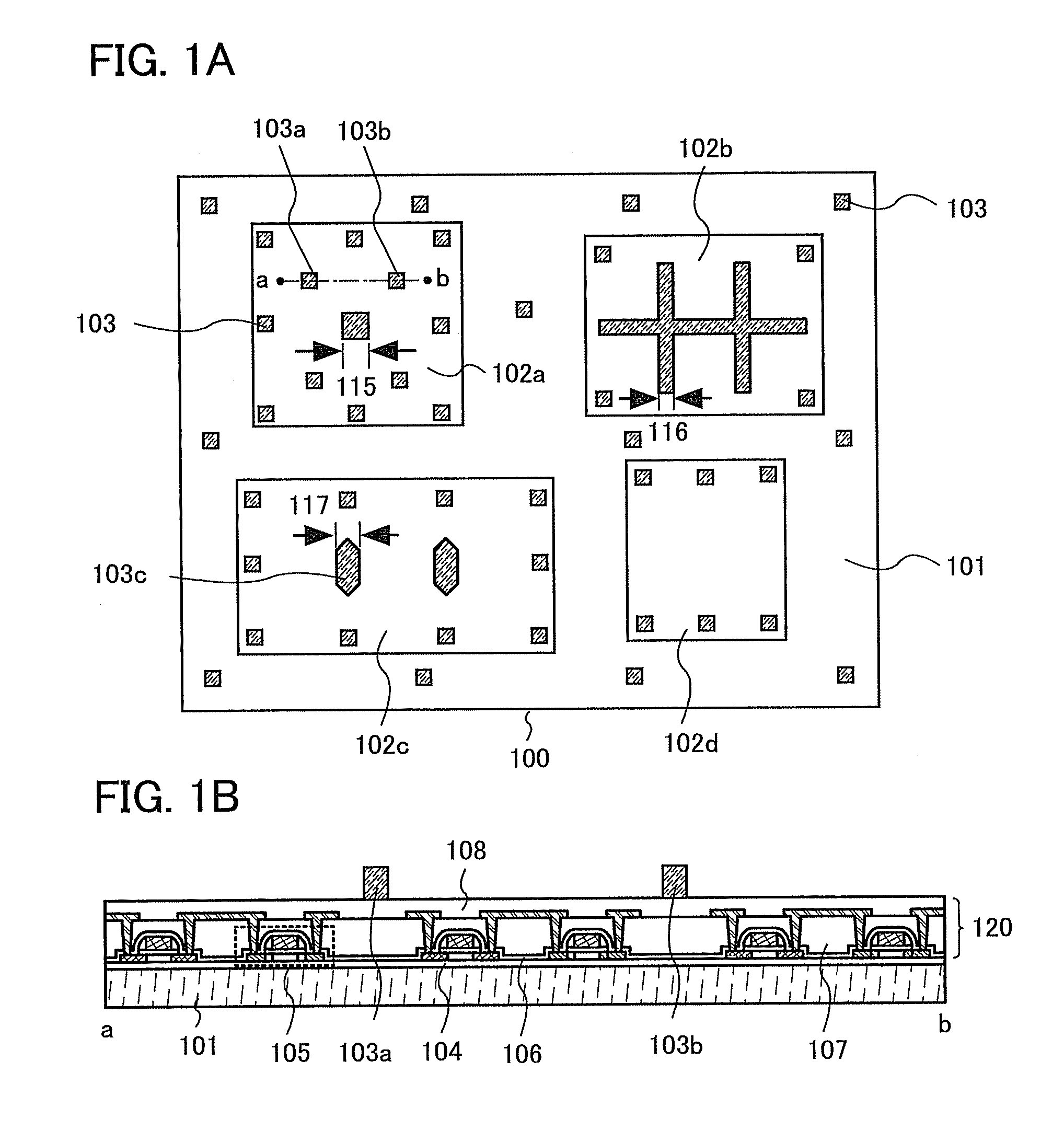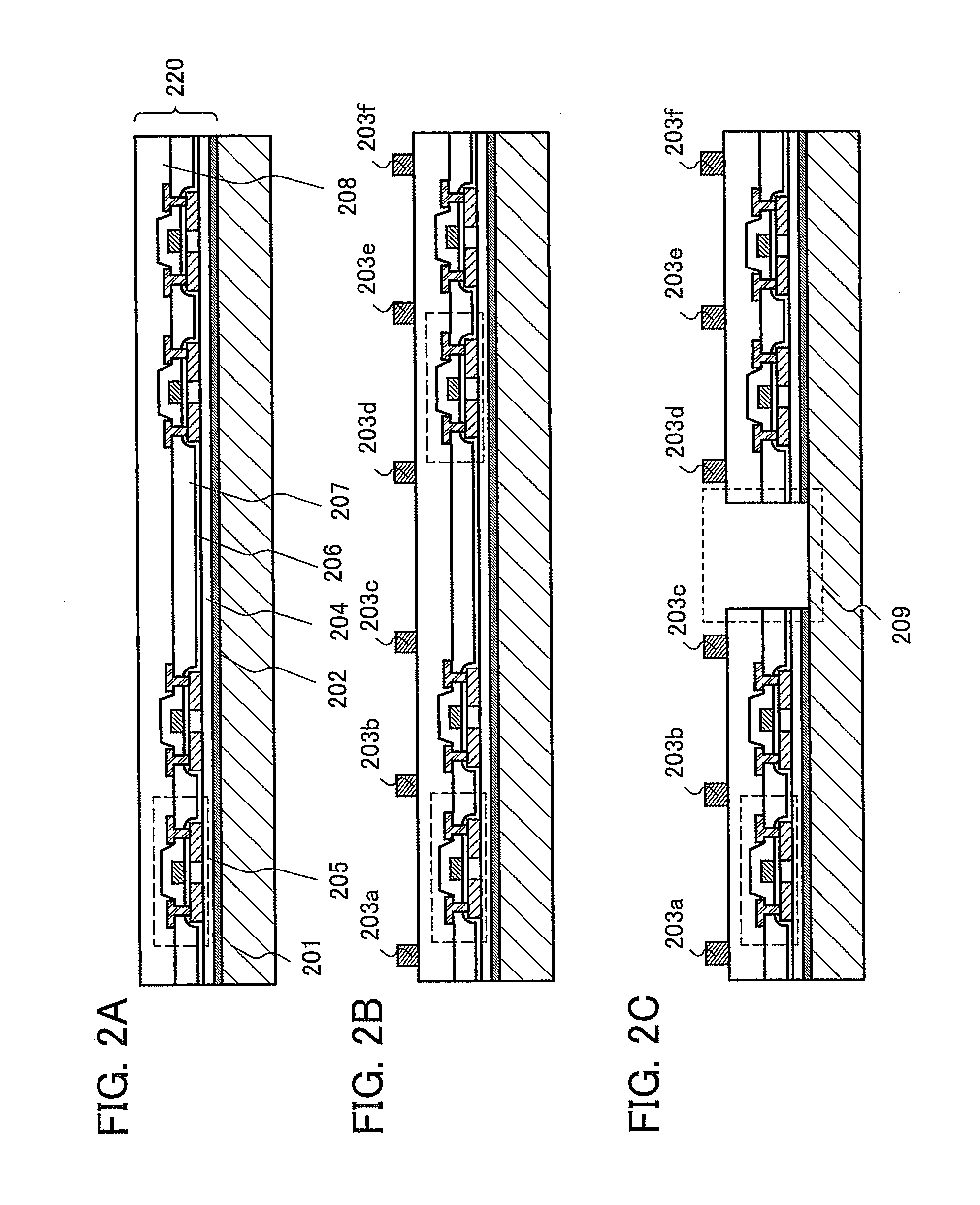Semiconductor Device and Method for Manufacturing Semiconductor Device
a semiconductor device and semiconductor technology, applied in the field of semiconductor devices, can solve problems such as damage to the semiconductor element of the semiconductor device, and achieve the effect of high-reliability semiconductor devices
- Summary
- Abstract
- Description
- Claims
- Application Information
AI Technical Summary
Benefits of technology
Problems solved by technology
Method used
Image
Examples
embodiment mode 1
[0026]In this embodiment mode, a structural example of a semiconductor device of the present invention is described with reference to drawings.
[0027]FIG. 1A shows a top structure of a semiconductor device 100 of this embodiment mode. The semiconductor device 100 includes blocks 102a to 102d provided over a substrate 101. A projecting member 103 is provided between blocks and projecting members are also provided in each of the blocks. In the case of taking a block 102a as an example, the projecting member 103 is provided in the periphery of the block 102a and projecting members are also provided in the block 102a.
[0028]The blocks 102a to 102d each include an element such as a transistor or a diode. As the diode, a variety of diodes such as a variable capacitance diode, a Schottky diode, and a tunnel diode can be applied.
[0029]Intervals at which a plurality of projecting members 103 are provided may each be set in a range of from 2 to 200 μm (preferably, from 50 to 150 μm). The plura...
embodiment mode 2
[0048]FIGS. 11A and 11B are views showing an example of a semiconductor device of this embodiment mode. This embodiment mode is similar to Embodiment Mode 1 except that openings are formed in an element layer, a plurality of projecting members are provided in the openings, and the longitudinal elastic modulus of the material of the plurality of projecting members is higher than that of the materials of a first insulating layer and a second insulating layer. A specific example of the element layer is similar to the element layer described in Embodiment Mode 1. Hereinafter, like reference numerals refer to like parts between the structure of this embodiment mode and the structure of Embodiment Mode 1, and description thereof is omitted.
[0049]First, all of the insulating films 104 to 108 of the element layer 120 are removed to form openings. Note that it is preferable that the insulating film 104 be not removed and the insulating films 106 to 108 be removed to form openings.
[0050]Proje...
embodiment mode 3
[0059]In this embodiment mode, an example of a method for manufacturing a semiconductor device of the present invention is described with reference to FIGS. 2A to 3F.
[0060]Here, an example where an element layer is provided over a substrate with a release layer interposed therebetween and then the element layer is separated from the substrate is described.
[0061]In this embodiment mode, an example where after an element layer including an element such as a transistor is provided over a rigid substrate such as a glass substrate, the element layer is separated from the rigid substrate by a release method and the element layer is provided over another substrate so that a semiconductor device is manufactured is described.
[0062]First, a release layer 202 is formed over a substrate 201 (also referred to as a first substrate), and an element layer 220 including an insulating film 204 (also referred to as a first insulating film), a thin film transistor 205 (also referred to as a TFT), an in...
PUM
 Login to View More
Login to View More Abstract
Description
Claims
Application Information
 Login to View More
Login to View More - R&D
- Intellectual Property
- Life Sciences
- Materials
- Tech Scout
- Unparalleled Data Quality
- Higher Quality Content
- 60% Fewer Hallucinations
Browse by: Latest US Patents, China's latest patents, Technical Efficacy Thesaurus, Application Domain, Technology Topic, Popular Technical Reports.
© 2025 PatSnap. All rights reserved.Legal|Privacy policy|Modern Slavery Act Transparency Statement|Sitemap|About US| Contact US: help@patsnap.com



